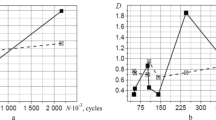Abstract
Fatigue reliability assessment of metallic structures in various applications according current design codes is based mostly on S-N criteria with uncertain characterization of fatigue properties of a particular material and the assumed damage. In case the crack is detected residual service life as recommended may be estimated by applying the Linear fracture mechanics techniques, again, with incomplete defining conditions of the crack growth and exhaustion of life.
Proposed earlier procedure of simulation the fatigue process based on the due finite element modeling of the affected area of a structure, application of the damage summation technique and appropriate criterion for fatigue failure of material allowed assessment of fatigue life from the onset of service loading up to development of a critical state, e.g. of the through crack in a structural component. Also, it was shown that the simulation scheme was capable of account the heterogeneity of the material structure fatigue resistance, the crack closure effects and elastic-plastic material response when the Strain-life criterion for fatigue failure was applied.
However, selection of the criterion for fatigue failure of material is but a straightforward decision: it is shown that S-N criterion even attributed to the same structural steel class as the Strain-life one does not provide in analysis of the fatigue process even an approximate convergence. This is mostly due to fairly indirect considering the inelastic properties of fatigue damage in S-N criteria and the methodology of fatigue testing specimens aimed at evaluation of S-N and \(\Delta \varepsilon \)-N criteria.
Further, the approach would need in more comparisons of simulated and test data in different structural applications.
Access this chapter
Tax calculation will be finalised at checkout
Purchases are for personal use only
Similar content being viewed by others
References
Petinov, S.V., Guchinsky, R.V. Finite-element modeling of the semi-elliptical fatigue crack growth by the damage accumulation approach. In: Proceedings of the XLII International Summer School - Conference Advanced Problems in Mechanics, SPb-Repino, IPME RAS, pp. 296–306 (2014)
Guchinsky, R.V., Petinov, S.V.: Two-dimensional surface fatigue crack propagation and its finite element simulation. In: Applied Mechanics and Materials, Ch. 5, vol. 725–726, pp. 654–661 (2015)
Imran, M., Siddique, S., Guchinsky, R.V., Petinov, S.V., Walther, F.: Comparison of fatigue life assessment by analytical, experimental and damage accumulation modeling approach for steel SAE 1045. Fatigue Fract. Eng. Mater. Struct. 39(9), 1138–1149 (2016)
Veritas, D.N.: Fatigue Assessment of Ship Structures. Classification Notes 30.7, Hovik, Norway (2014)
Petinov, S.V., Thayamballi, A.K.: The application of S-N Curves considering mismatch of stress concentration between test specimen and structure. J. Ship Res. 42(1), 68 (1998)
Petinov, S.V., Reemsnyder, H.S. and Thayamballi, A.K.: The similitude of fatigue damage principle: application in S-N curves-based fatigue design. In: Marquis, G., Solin, J. (ed.) Fatigue Design and Reliability, pp. 219–228. ESIS Publication 23. Elsevier Science Ltd (1999)
EUROCODE 3: Design of Steel Structures. Part 1-9: Fatigue. BS EN 1993-1-9: 2009, p. 36
Bolotin, V.V.: Statistical Methods in Structural Mechanics. Holden-Day, San-Francisco (1969)
Glinka, G.A.: Cumulative model of fatigue crack growth. Int. J. Fatigue 4, 59–67 (1982)
Ellyin, F., Fakinlede, C.O.: Probabilistic simulation of fatigue crack growth by damage accumulation. Eng. Fract. Mech. 22(4), 697–712 (1985)
Fatemi, A., Plaseid, A., Khosrovaneh, A.K., Tanner, D.: Application of bi-linear log-log S-N model to strain-controlled fatigue data of aluminum alloys and its effect on life predictions. Int. J. Fatigue 27, 1040–1050 (2005)
Author information
Authors and Affiliations
Corresponding author
Editor information
Editors and Affiliations
Rights and permissions
Copyright information
© 2020 Springer Nature Switzerland AG
About this paper
Cite this paper
Guchinsky, R.V., Petinov, S.V. (2020). Fatigue Reliability of Structures: Methodology of Assessment and Problems. In: Indeitsev, D., Krivtsov, A. (eds) Advanced Problems in Mechanics. APM 2019. Lecture Notes in Mechanical Engineering. Springer, Cham. https://doi.org/10.1007/978-3-030-49882-5_12
Download citation
DOI: https://doi.org/10.1007/978-3-030-49882-5_12
Published:
Publisher Name: Springer, Cham
Print ISBN: 978-3-030-49881-8
Online ISBN: 978-3-030-49882-5
eBook Packages: EngineeringEngineering (R0)




